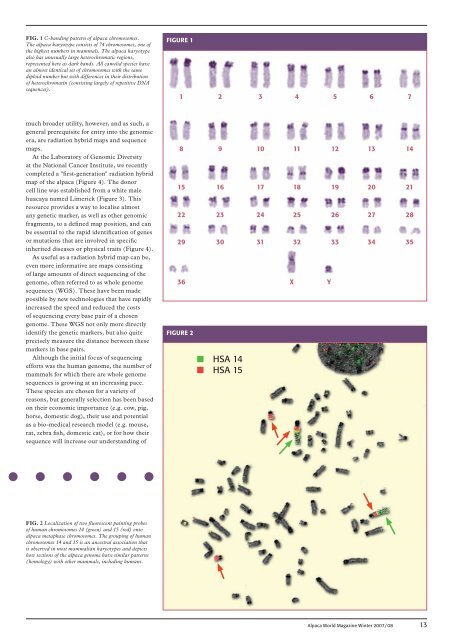Winter - Classical MileEnd Alpacas
Winter - Classical MileEnd Alpacas
Winter - Classical MileEnd Alpacas
You also want an ePaper? Increase the reach of your titles
YUMPU automatically turns print PDFs into web optimized ePapers that Google loves.
FIG. 1 C-banding pattern of alpaca chromosomes.<br />
The alpaca karyotype consists of 74 chromosomes, one of<br />
the highest numbers in mammals. The alpaca karyotype<br />
also has unusually large heterochromatic regions,<br />
represented here as dark bands. All camelid species have<br />
an almost identical set of chromosomes with the same<br />
diploid number but with differences in their distribution<br />
of heterochromatin (consisting largely of repetitive DNA<br />
sequences).<br />
Figure 1<br />
1 2 3 4 5 6 7<br />
much broader utility, however, and as such, a<br />
general prerequisite for entry into the genomic<br />
era, are radiation hybrid maps and sequence<br />
maps.<br />
At the Laboratory of Genomic Diversity<br />
at the National Cancer Institute, we recently<br />
completed a "first-generation" radiation hybrid<br />
map of the alpaca (Figure 4). The donor<br />
cell line was established from a white male<br />
huacaya named Limerick (Figure 3). This<br />
resource provides a way to localise almost<br />
any genetic marker, as well as other genomic<br />
fragments, to a defined map position, and can<br />
be essential to the rapid identification of genes<br />
or mutations that are involved in specific<br />
inherited diseases or physical traits (Figure 4).<br />
As useful as a radiation hybrid map can be,<br />
even more informative are maps consisting<br />
of large amounts of direct sequencing of the<br />
genome, often referred to as whole genome<br />
sequences (WGS). These have been made<br />
possible by new technologies that have rapidly<br />
increased the speed and reduced the costs<br />
of sequencing every base pair of a chosen<br />
genome. These WGS not only more directly<br />
identify the genetic markers, but also quite<br />
precisely measure the distance between these<br />
markers in base pairs.<br />
Although the initial focus of sequencing<br />
efforts was the human genome, the number of<br />
mammals for which there are whole genome<br />
sequences is growing at an increasing pace.<br />
These species are chosen for a variety of<br />
reasons, but generally selection has been based<br />
on their economic importance (e.g. cow, pig,<br />
horse, domestic dog), their use and potential<br />
as a bio-medical research model (e.g. mouse,<br />
rat, zebra fish, domestic cat), or for how their<br />
sequence will increase our understanding of<br />
8 9 10 11 12 13 14<br />
15 16 17 18 19 20 21<br />
22 23 24 25 26 27 28<br />
29 30 31 32 33 34 35<br />
36 X Y<br />
Figure 2<br />
■ HSA 14<br />
■ HSA 15<br />
FIG. 2 Localization of two fluorescent painting probes<br />
of human chromosomes 14 (green) and 15 (red) onto<br />
alpaca metaphase chromosomes. The grouping of human<br />
chromosomes 14 and 15 is an ancestral association that<br />
is observed in most mammalian karyotypes and depicts<br />
how sections of the alpaca genome have similar patterns<br />
(homology) with other mammals, including humans.<br />
Alpaca World Magazine <strong>Winter</strong> 2007 / 08<br />
13







